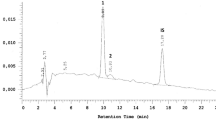Summary
The effect of genotype, nitrogen fertilization and location on vitreousness of 20 durum wheat varieties was studied under rainfed conditions. All these interacting factors affected virtreousness with genotype being the most important. Nine of the varieties tested, produced grains of high vitreousness under different environmental conditions even without nitrogen fertilization. Screening for vitreousness appeared more efficient if no nitrogen fertilization is used and in locations where vitreousness is generally low. There was a tendency for largeseeded varieties to produce grains of high vitreousness. Vitreousness of varieties was correlated with crude protein content when nitrogen supply was low. It was concluded that breeding is a very potent way to improve vitreousness.
Similar content being viewed by others
References
Anonymous, 1973. American Association of Cereal Chemists, AACC, 46-14 Method. The Association, St. Paul, Minn., USA.
Bagnara, D., L. Rossi & G. Porreca, 1973. Mutagenesis in Triticum durum: Mutagens for protein content obtained from the cv. Capeiti. In: G. T. Scarascia-Mungnozza (Ed.), Genetics and breeding of durum wheat. Proc. Symp. Bari, 679–686.
Hadjichristodoulou, A., Athena Della & C. Josephides, 1977. A new durum wheat variety, Aronas. Techn. Bull. 22, Cyprus Agricultural Research Institute, Nicosia.
Irvine, G. N., 1971. Durum wheat and paste products. In: Y. Pomeranz (Ed.), Wheat chemistry and technology. Amer. Assoc. Cer. Chem., St. Paul, Minnesota, 777–796.
Matveef, M., 1964. La mitadinage de blés durs, son évaluation et son influence sur le rendement at la valeur des semoules. Bulletin des Anciens Élèves L'École Française de Maunerie 198: 1–8.
Menger, A., 1973. Problems concerning vitreousness and hardness of kernels as quality factors of durum wheat. In: G. T. Scarascia-Mugnozza (Ed.), Genetics and breeding of durum wheat. Proc. Symp. Bari. 563–571.
Mosconi, G. & A. Bozzini, 1973. Effects of application of late nitrogen fertilizer to durum wheat. Revista di Agronomia 7: 75–82 (cited in Field Crop Abstr. (1975) 4226).
Steel, R. G. D. & J. H. Torrie, 1960. Principles and procedures of statistics. McGraw-Hill Book Co. Inc. N. York.
Author information
Authors and Affiliations
Rights and permissions
About this article
Cite this article
Hadjichristodoulou, A. Genetic and environmental effects on vitreousness of durum wheat. Euphytica 28, 711–716 (1979). https://doi.org/10.1007/BF00038938
Received:
Issue Date:
DOI: https://doi.org/10.1007/BF00038938




